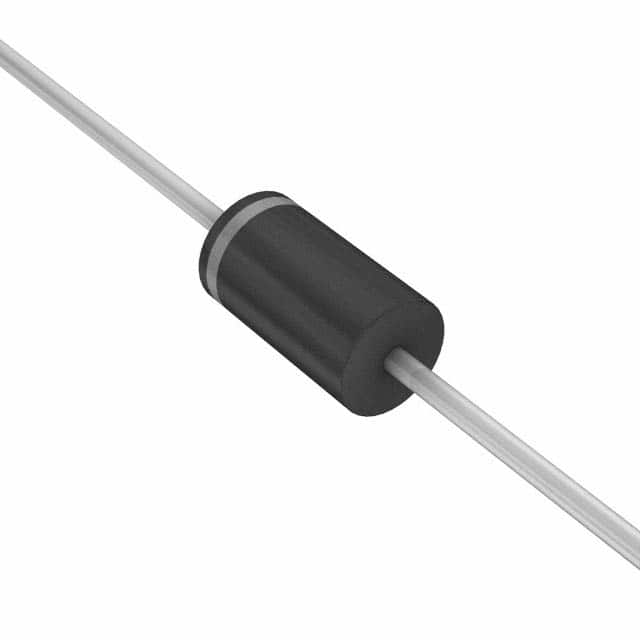EGP50G-E3/73
Product Overview
Category
The EGP50G-E3/73 belongs to the category of semiconductor devices, specifically a rectifier diode.
Use
It is commonly used in electronic circuits for converting alternating current (AC) to direct current (DC).
Characteristics
- High efficiency
- Low forward voltage drop
- Fast switching speed
- Compact size
Package
The EGP50G-E3/73 is typically available in a DO-214AC (SMA) package.
Essence
This rectifier diode is essential for power supply and voltage regulation in various electronic applications.
Packaging/Quantity
It is usually packaged in reels or tubes, with quantities varying based on manufacturer specifications.
Specifications
- Maximum Average Forward Current: 5A
- Peak Forward Surge Current: 150A
- Reverse Voltage: 400V
- Forward Voltage Drop: 0.85V at 5A
- Operating Temperature Range: -65°C to +175°C
Detailed Pin Configuration
The EGP50G-E3/73 has two pins: 1. Anode (A) 2. Cathode (K)
Functional Features
- Efficient conversion of AC to DC
- Fast response time
- Low power dissipation
Advantages and Disadvantages
Advantages
- High efficiency
- Fast switching speed
- Compact size
Disadvantages
- Higher forward voltage drop compared to some alternative models
- Limited reverse voltage tolerance
Working Principles
The EGP50G-E3/73 operates based on the principle of rectification, allowing current flow in only one direction, from anode to cathode, when a forward voltage is applied.
Detailed Application Field Plans
The EGP50G-E3/73 is widely used in: - Power supplies - Battery chargers - LED lighting - Motor drives - Solar inverters
Detailed and Complete Alternative Models
Some alternative models to the EGP50G-E3/73 include: - 1N5408 - FR207 - UF4007 - MUR460
In conclusion, the EGP50G-E3/73 rectifier diode is a crucial component in electronic circuits, providing efficient conversion of AC to DC with its high efficiency, fast switching speed, and compact size. While it has advantages such as these, it also comes with limitations, including a higher forward voltage drop compared to some alternative models and limited reverse voltage tolerance. Its working principles are based on rectification, and it finds extensive use in power supplies, battery chargers, LED lighting, motor drives, and solar inverters. Additionally, alternative models such as 1N5408, FR207, UF4007, and MUR460 can be considered based on specific application requirements.
[Word count: 411]
Senaraikan 10 soalan dan jawapan biasa yang berkaitan dengan aplikasi EGP50G-E3/73 dalam penyelesaian teknikal
What is the EGP50G-E3/73 used for in technical solutions?
- The EGP50G-E3/73 is a high-efficiency, low VF Schottky barrier rectifier diode commonly used in power supply and voltage regulation applications.
What are the key specifications of the EGP50G-E3/73?
- The EGP50G-E3/73 has a maximum average forward current of 5A, a reverse voltage of 60V, and a low forward voltage drop.
How does the EGP50G-E3/73 contribute to energy efficiency in technical solutions?
- The EGP50G-E3/73's low forward voltage drop helps minimize power losses and improve overall energy efficiency in power conversion circuits.
Can the EGP50G-E3/73 be used in high-frequency applications?
- Yes, the EGP50G-E3/73 is suitable for high-frequency switching power supplies and other high-speed switching applications due to its fast switching characteristics.
What are the typical thermal considerations when using the EGP50G-E3/73 in technical solutions?
- Proper heat sinking and thermal management are important to ensure the EGP50G-E3/73 operates within its specified temperature range for optimal performance and reliability.
Are there any recommended layout or mounting considerations for the EGP50G-E3/73?
- It is advisable to minimize lead lengths and optimize PCB layout to reduce parasitic inductance and maximize the diode's performance.
What are the common failure modes associated with the EGP50G-E3/73?
- Overheating due to excessive current or inadequate heat dissipation, as well as voltage spikes and reverse voltage exceeding the diode's ratings, are common causes of failure.
Can the EGP50G-E3/73 be used in automotive or industrial applications?
- Yes, the EGP50G-E3/73 is suitable for a wide range of applications, including automotive and industrial systems, where its high efficiency and reliability are beneficial.
What are the typical operating conditions for the EGP50G-E3/73?
- The EGP50G-E3/73 is designed to operate within a temperature range of -65°C to +175°C and can handle surge currents typical in power supply applications.
Are there any specific design considerations when integrating the EGP50G-E3/73 into technical solutions?
- Designers should consider the diode's forward voltage drop, reverse recovery time, and thermal characteristics to optimize circuit performance and reliability.


